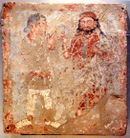Kushan Empire
|
|||||||||||||||||||||||||||||||
The Kushan Empire originally formed in the 1st century AD in the territories of ancient Bactria on either side of the middle course of the Oxus River or Amu Darya in what is now northern Afghanistan, and southern Tajikistan and Uzbekistan.[2]
During the 1st and early 2nd centuries AD the Kushans expanded rapidly across the northern part of the Indian subcontinent at least as far as Saketa and Sarnath near Varanasi (Benares) where inscriptions have been found dated to the first few years of era of the most famous Kushan ruler, Kanishka which apparently began about 127 AD.[3][4][5]
The Kushan kings were a branch of the Yuezhi confederation (possibly intermarried with local families) and they had diplomatic contacts with Rome, Persia and Han China. While much philosophy, art, and science was created within its borders, the only textual record we have of the empire's history today comes from inscriptions and accounts in other languages, particularly Chinese.[6] The empire declined from 3rd century and fell to the Sassanid empire and Gupta Empire.
Contents |
Origins
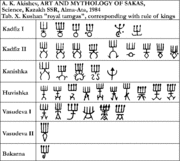
Chinese sources describe the Guishuang (Ch: 貴霜), i.e. the "Kushans", as one of the five aristocratic tribes of the Yuezhi, Yueh-chi or Yüeh-chih in other transcriptions,[7] (Ch: 月氏), a loose confederation of Indo-European peoples.[8] The Yuezhi are also generally considered as the easternmost speakers of Indo-European languages, who had been living in the arid grasslands of eastern Central Asia, in modern-day Xinjiang and Gansu, possibly speaking versions of the Tocharian language, until they were driven west by the Xiongnu in 176–160 BC. The five tribes constituting the Yuezhi are known in Chinese history as Xiūmì (Ch: 休密), Guishuang (Ch: 貴霜), Shuangmi (Ch: 雙靡), Xidun (Ch: 肸頓), and Dūmì (Ch: 都密).
Historian John Keay contextualizes the movements of the Kushan within a larger setting of mass migrations taking place in the region:
Chinese sources tell of the construction of the Great Wall in the third century BC and the repulse of various marauding tribes. Forced to head west and eventually south, these tribes displaced others in an ethnic knock-on effect which lasted many decades and spread right across Central Asia. The Parthians from Iran and the Bactrian Greeks from Bactria had both been dislodged by the Shakas coming down from somewhere near the Aral Sea. But the Shakas had in turn been dislodged by the Yueh-chi who had themselves been driven west to Xinjiang by the Hiung-nu. The last, otherwise the Huns, would happily not reach India for a long time. But the Yueh-chi continued to press on the Shakas, and having forced them out of Bactria, it was sections or clans of these Yueh-chi who next began to move down into India in the second half of the first century AD."[9]
The Yuezhi reached the Hellenic kingdom of Greco-Bactria, in the Bactrian territory (northernmost Afghanistan and Uzbekistan) around 135 BC. The displaced Greek dynasties resettled to the southeast in areas of the Hindu Kush and the Indus basin (in present day Pakistan), occupying the western part of the Indo-Greek Kingdom.
General Cunningham identified Kushans as Gurjars (or Gujjars).[10] Word Gusur is referred in Rabatak inscription of Kushan king Kanishka.According to some scholars the Word Gusur, which means Kulputra or man or woman born in high family, in this inscription stands for Gujar or Gurjaras.[11][12][13]Gurjars of central asia are termed as Gusur (Gujur) even today.
Early Kushans

Some traces remain of the presence of the Kushans in the area of Bactria and Sogdiana. Archaeological structures are known in Takht-I-Sangin, Surkh Kotal (a monumental temple), and in the palace of Khalchayan. Various sculptures and friezes are known, representing horse-riding archers[14], and significantly men with artificially deformed skulls, such as the Kushan prince of Khalchayan[15] (a practice well attested in nomadic Central Asia). The Chinese first referred to these people as the Yuezhi and said they established the Kushan Empire, although the relationship between the Yuezhi and the Kushans is still unclear. On the ruins of ancient Hellenistic cities such as Ai-Khanoum, the Kushans are known to have built fortresses. The earliest documented ruler, and the first one to proclaim himself as a Kushan ruler was Heraios. He calls himself a "Tyrant" on his coins, and also exhibits skull deformation. He may have been an ally of the Greeks, and he shared the same style of coinage. Heraios may have been the father of the first Kushan emperor Kujula Kadphises.
The Chinese history, the Hou Hanshu, gives an account of the formation of the Kushan empire based on a report made by the Chinese general Ban Yong to the Chinese Emperor c. 125 AD:
"More than a hundred years later [than the conquest of Bactria by the Da Yuezhi], the prince [xihou] of Guishuang (Badakhshan) established himself as king, and his dynasty was called that of the Guishuang [Kushan] King. He invaded Anxi [Indo-Parthia], and took the Gaofu (Kabul) region. He also defeated the whole of the kingdoms of Puda (Paktiya) and Jibin (Kapisha and Gandhara). Qiujiuque (Kujula Kadphises) was more than eighty years old when he died. His son, Yangaozhen [probably Vema Tahk(tu) or, possibly, his brother Sadaṣkaṇa], became king in his place. He defeated Tianzhu [North-western India] and installed Generals to supervise and lead it. The Yuezhi then became extremely rich. All the kingdoms call [their king] the Guishuang [Kushan] king, but the Han call them by their original name, Da Yuezhi."[16][17]
Diverse cultural influences
In the following century, the Guishuang (Ch: 貴霜) gained prominence over the other Yuezhi tribes, and welded them into a tight confederation under yabgu (Commander) Kujula Kadphises. The name Guishuang was adopted in the West and modified into Kushan to designate the confederation, although the Chinese continued to call them Yuezhi.

Gradually wresting control of the area from the Scythian tribes, the Kushans expanded south into the region traditionally known as Gandhara (An area lying primarily in Pakistan's Pothowar, and Northwest Frontier Provinces region but going in an arc to include Kabul valley and part of Qandahar in Afghanistan) and established twin capitals near present-day Kabul and Peshawar then known as Kapisa and Pushklavati respectively.

The Kushans adopted elements of the Hellenistic culture of Bactria. They adopted the Greek alphabet (often corrupted) to suit their own language (with the additional development of the letter Þ "sh", as in "Kushan") and soon began minting coinage on the Greek model. On their coins they used Greek language legends combined with Pali legends (in the Kharoshthi script), until the first few years of the reign of Kanishka. After that date, they used Kushan language legends (in an adapted Greek script), combined with legends in Greek (Greek script) and legends in Pali (Kharoshthi script).
The Kushans are believed to have been predominantly zoaroastrian. However, from the time of Wima Takto, many Kushans started adopting aspects of Buddhist culture. Like the Egyptians they absorbed the strong remnants of the Greek Culture of the Hellenistic Kingdoms, becoming at least partly Hellenised. The great Kushan emperor Wima Kadphises may have embraced Saivism, as surmised by coins minted during the period. The following Kushan emperors represented a wide variety of faiths including Zoroastrianism, Buddhism, and possibly Saivism (a sect of Hinduism).
The rule of the Kushans linked the seagoing trade of the Indian Ocean with the commerce of the Silk Road through the long-civilized Indus Valley. At the height of the dynasty, the Kushans loosely oversaw a territory that extended to the Aral Sea through present-day Uzbekistan, Afghanistan, and Pakistan into northern India.
The loose unity and comparative peace of such a vast expanse encouraged long-distance trade, brought Chinese silks to Rome, and created strings of flourishing urban centers.
Territorial expansion


Direct archaeological evidence of a Kushan rule of long duration is basically available in an area stretching from Surkh Kotal, Begram, the summer capital of the Kushans, Peshawar the capital under Kanishka I, Taxila and Mathura, the winter capital of the Kushans.[18]
Other areas of probable rule include Khwarezm (Russian archaeological findings)[18] Kausambi (excavations of the Allahabad University),[18] Sanchi and Sarnath (inscriptions with names and dates of Kushan kings),[18] Malwa and Maharashtra,[19] Orissa (imitation of Kushan coins, and large Kushan hoards).[18]
The recently discovered Rabatak inscription confirms the account of the 3rd century Chinese history, the Weilüe, and inscriptions dated early in the Kanishka era (incept probably 127 CE), that large Kushan dominions expanded into in the heartland of northern India in the early 2nd century CE. The lines 4 to 7 of the inscription[20] describe the cities which were under the rule of Kanishka, among which six names are identifiable: Ujjain, Kundina, Saketa, Kausambi, Pataliputra, and Champa (although the text is not clear whether Champa was a possession of Kanishka or just beyond it).[21][22][23]
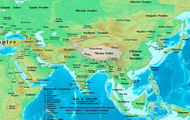
Northward, in the 2nd century CE, the Kushans under Kanishka made various forays into the Tarim Basin, seemingly the original ground of their ancestors the Yuezhi, where they had various contacts with the Chinese. Both archaeological findings and literary evidence suggest Kushan rule, in Kashgar, Yarkand and Khotan.[18]
As late as the 3rd century AD, decorated coins of Huvishka were dedicated at Bodh Gaya together with other gold offerings under the "Enlightenment Throne" of the Buddha, suggesting direct Kushan influence in the area during that period.[24]
Main Kushan rulers
Kujula Kadphises (ca 30 – ca 80)

According to the Hou Hanshu:
". . . the prince [xihou] of Guishuang, named Qiujiuque [Kujula Kadphises], attacked and exterminated the four other xihou. He established himself as king, and his dynasty was called that of the Guishuang [Kushan] King. He invaded Anxi [Indo-Parthia], and took the Gaofu [Kabul] region. He also defeated the whole of the kingdoms of Puda [Paktiya] and Jibin [Kapisha and Gandhara]. Qiujiuque [Kujula Kadphises] was more than eighty years old when he died."[16]
These conquests probably took place sometime between 45 and 60, and laid the basis for the Kushan Empire which was rapidly expanded by his descendants.
Kujula issued an extensive series of coins and fathered at least two sons, Sadaṣkaṇa (who is known from only two inscriptions, especially the Rabatak inscription, and apparently never have ruled), and seemingly Vima Taktu.
Kujula Kadphises was the great grandfather of Kanishka.
Vima Taktu or Sadashkana (ca 80 – ca 95)
Vima Takt[u] (or Tak[to]; Ancient Chinese: 閻膏珍 Yangaozhen) is not mentioned in the Rabatak inscription (Sadashkana is instead. See also the reference to Sims-William’s article below). He was the predecessor of Vima Kadphises, and Kanishka I. He expanded the Kushan Empire into the northwest of the Indian subcontinent. The Hou Hanshu says:
- "His son, Yangaozhen [probably Vema Tahk(tu) or, possibly, his brother Sadaṣkaṇa], became king in his place. He defeated Tianzhu [North-western India] and installed Generals to supervise and lead it. The Yuezhi then became extremely rich. All the kingdoms call [their king] the Guishuang [Kushan] king, but the Han call them by their original name, Da Yuezhi."[16]
Vima Kadphises (ca 95 – ca 127)
Vima Kadphises (Kushan language: Οοημο Καδφισης) was a Kushan emperor from around 90–100 AD, the son of Sadashkana and the grandson of Kujula Kadphises, and the father of Kanishka I, as detailed by the Rabatak inscription.
Vima Kadphises added to the Kushan territory by his conquests in Afghanistan and north-west Pakistan. He issued an extensive series of coins and inscriptions. He was the first to introduce gold coinage in India, in addition to the existing copper and silver coinage.
Kanishka I (ca 127 – ca 140)
The rule of Kanishka, fifth Kushan king, who flourished for about 13 years from c. 127. Upon his accession, Kanishka ruled a huge territory (virtually all of northern India), south to Ujjain and Kundina and east beyond Pataliputra, according to the Rabatak inscription:

- "In the year one, it has been proclaimed unto India, unto the whole realm of the governing class, including Koonadeano (Kaundinya< Kundina) and the city of Ozeno (Ozene, Ujjain) and the city of Zageda (Saketa) and the city of Kozambo (Kausambi) and the city of Palabotro (Pataliputra) and so long unto (i.e. as far as) the city of Ziri-tambo (Sri-Champa)." Rabatak inscription, Lines 4–6.
His territory was administered from two capitals: Purushapura (now Peshawar in northern Pakistan) and Mathura, in northern India. He is also credited (along with Raja Dab) for building the massive, ancient Fort at Bathinda (Qila Mubarak), in the modern city of Bathinda, Indian Punjab.
The Kushans also had a summer capital in Bagram (then known as Kapisa), where the "Begram Treasure", comprising works of art from Greece to China, has been found. According to the Rabatak inscription, Kanishka was the son of Vima Kadphises, the grandson of Sadashkana, and the great-grandson of Kujula Kadphises. Kanishka’s era is now generally accepted to have begun in 127 on the basis of Harry Falk’s ground-breaking research.[25][26] Kanishka’s era was used as a calendar reference by the Kushans for about a century, until the decline of the Kushan realm.
Vāsishka (ca 140 - ca 160)
Vāsishka was a Kushan emperor, who seems to have a 20 year reign following Kanishka. His rule is recorded as far south as Sanchi (near Vidisa), where several inscriptions in his name have been found, dated to the year 22 (The Sanchi inscription of "Vaksushana" – i. e. Vasishka Kushana) and year 28 (The Sanchi inscription of Vasaska – i. e. Vasishka) of the Kanishka era.

Huvishka (ca 160 – ca 190)
Huvishka (Kushan: Οοηϸκι, "Ooishki") was a Kushan emperor from about 20 years after the death of Kanishka (assumed on the best evidence available to be in 140 AD) until the succession of Vasudeva I about thirty years later. His rule was a period of retrenchment and consolidation for the Empire. In particular he devoted time and effort early in his reign to the exertion of greater control over the city of Mathura.
Vasudeva I (ca 190 – ca 230)

Vasudeva I (Kushan: Βαζοδηο "Bazodeo", Chinese: 波調 "Bodiao") was the last of the "Great Kushans." Named inscriptions dating from year 64 to 98 of Kanishka’s era suggest his reign extended from at least 191 to 225 AD. He was the last great Kushan emperor, and the end of his rule coincides with the invasion of the Sassanids as far as northwestern India, and the establishment of the Indo-Sassanids or Kushanshahs from around 240 AD.
Kushan deities

The Kushan religious pantheon is extremely varied, as revealed by their coins and their seals, on which more than 30 different gods appear, belonging to the Hellenistic, the Iranian, and to a lesser extent the Indian world. Greek deities, with Greek names are represented on early coins. During Kanishka's reign, the language of the coinage changes to Bactrian (though it remained in Greek script for all kings). After Huvishka, only two divinities appear on the coins: Ardoxsho and Oesho (see details below).
Representation of entities from Greek mythology and Hellenistic syncretism are:
- Ηλιος (Helios), Ηφαηστος (Hephaistos), Σαληνη (Selene), Ανημος (Anemos). Further, the coins of Huvishka also portray two demi-gods: erakilo Heracles, and sarapo Sarapis.
The Indic entities represented on coinage include:
- Βοδδο (boddo, Buddha)
- Μετραγο Βοδδο (metrago boddo, bodhisattava Maitreya)
- Mαασηνo (maaseno, Mahasena)
- Σκανδo koμαρo (skando komaro, Skanda Kumara)
- þακαμανο Βοδδο (shakamano boddho, Shakyamuni Buddha)
The Iranic entities depicted on coinage include:
- Αρδοχþο (ardoxsho, Ashi Vanghuhi)
- Aþαειχþo (ashaeixsho, Asha Vahishta)
- Αθþο (athsho, Atar)
- Φαρρο (pharro, Khwarenah)
- Λροοασπο (lrooaspa, Drvaspa)
- Μαναοβαγο, (manaobago, Vohu Manah)
- Μαο (mao, Mah)
- Μιθρο, Μιιρο, Μιορο, Μιυρο (mithro and variants, Mithra)
- Μοζδοοανο (mozdooano, Mazda *vana "Mazda the victorious?")
- Νανα, Ναναια, Ναναϸαο (variations of pan-Asiatic nana, Sogdian nny, in a Zoroastrian context Aredvi Sura Anahita)
- Οαδο (oado Vata)
- Oαxþo (oaxsho, "Oxus")
- Ooρoμoζδο (ooromozdo, Ahura Mazda)
- Οραλαγνο (orlagno, Verethragna)
- Τιερο (tiero, Tir)
Additionally,
- Οηϸο (oesho), long considered to represent Indic Shiva,[28] but more recently identified as Avestan Vayu conflated with Shiva.[29][30]
- Two copper coins of Huvishka bear a 'Ganesa' legend, but instead of depicting the typical theriomorphic figure of Ganesha, have a figure of an archer holding a full-length bow with string inwards and an arrow. This is typically a depiction of Rudra, but in the case of these two coins is generally assumed to represent Shiva.
Some deities on Kushan coinage
 Mahasena on a coin of Huvishka. |
Four-faced Oisho. |
Rishti. |
Manaobago. |
|
Pharro. |
Ardochsho. |
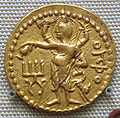 Oisho |
 Oisho with bull. |
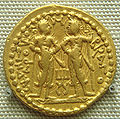 Skanda and Visakha. |
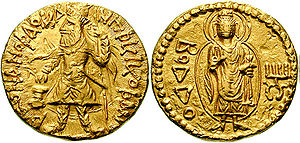 Gold coin of Kanishka I, with a depiction of the Buddha, with the legend "Boddo" in Greek script. Ahin Posh. |
 Kushan Carnelian seal representing the "ΑΔϷΟ" (adsho Atar), with triratana symbol left, and Kanishka's dynastic mark right. |
The Kushans and Buddhism
Cultural exchanges also flourished, encouraging the development of Greco-Buddhism, a fusion of Hellenistic and Buddhist cultural elements, that was to expand into central and northern Asia.
Kanishka is renowned in Buddhist tradition for having convened a great Buddhist council in Kashmir. Kanishka also had the original Gandhari vernacular, or Prakrit, Buddhist texts translated into the language of Sanskrit. Along with the Indian emperors Ashoka and Harsha Vardhana and the Indo-Greek king Menander I (Milinda), Kanishka is considered by Buddhism as one of its greatest benefactors.
Kushan art
The art and culture of Gandhara, at the crossroads of the Kushan hegemony, are the best known expressions of Kushan influences to Westerners. Several direct depictions of Kushans are known from Gandhara, where they are represented with a tunic, belt and trousers and play the role of devotees to the Buddha, as well as the Bodhisattva and future Buddha Maitreya.
In the iconography, they are never associated however with the very Hellenistic "Standing Buddha" statues (See image), which might therefore correspond to an earlier historical period. The style of these friezes incorporating Kushan devotees is already strongly Indianized, quite remote from earlier Hellenistic depictions of the Buddha:
|
Kushan costume. |
Detail of the face of a Kushan devotee. |
Flaming Buddha with Kushan devotees around Maitreya. |
Maitreya, with Kushan devotee couple. 2nd century Gandhara. |
 Detail of Kushan devotee. |
Maitreya, with Kushan devotees, left and right. 2nd century Gandhara. |
Maitreya, with Indian (left) and Kushan (right) devotees. |
Kushans worshipping the Buddha's bowl. 2nd century Gandhara. |
|
Buddha triad and kneeling Kushan devotee couple. 3rd century. |
 Kushan devotee (Mathura). |
Stucco head of a Kushan man. Gandhara. |
|
|
Kushan devotee in the traditional costume with tunic and boots, 2nd century, Gandhara. |
 Butkara stupa under the Kushans.[31] |
Contacts with Rome
- See also: Roman trade with India
Several Roman sources describe the visit of ambassadors from the Kings of Bactria and India during the 2nd century, probably referring to the Kushans.

Historia Augusta, speaking of Emperor Hadrian (117–138) tells:
- "Reges Bactrianorum legatos ad eum, amicitiae petendae causa, supplices miserunt"
- "The kings of the Bactrians sent supplicant ambassadors to him, to seek his friendship."
Also in 138, according to Aurelius Victor (Epitome‚ XV, 4), and Appian (Praef., 7), Antoninus Pius, successor to Hadrian, received some Indian, Bactrian (Kushan) and Hyrcanian ambassadors.
The Hou Hanshu reports: "Precious things from Da Qin [the Roman Empire] can be found there [in Tianzhu or Northwestern India], as well as fine cotton cloths, fine wool carpets, perfumes of all sorts, sugar candy, pepper, ginger, and black salt."[32]
The summer capital of the Kushan in Begram has yielded a considerable amount of goods imported from the Roman Empire, in particular, various types of glassware.
Contacts with China
During the 1st and 2nd century, the Kushan Empire expanded militarily to the north and occupied parts of the Tarim Basin, their original grounds, putting them at the center of the profitable Central Asian commerce with the Roman Empire. They are related to have collaborated militarily with the Chinese against nomadic incursion, particularly when they collaborated with the Han-dynasty general Ban Chao against the Sogdians in 84, when the latter were trying to support a revolt by the king of Kashgar. Around 85, they also assisted the Chinese general in an attack on Turpan, east of the Tarim Basin.
In recognition for their support to the Chinese, the Kushans requested, but were denied, a Han princess, even after they had sent presents to the Chinese court. In retaliation, they marched on Ban Chao in 86 with a force of 70,000, but, exhausted by the expedition, were finally defeated by the smaller Chinese force. The Yuezhi retreated and paid tribute to the Chinese Empire during the reign of the Chinese emperor Han He (89–106).

Later, around 116, the Kushans under Kanishka established a kingdom centered on Kashgar, also taking control of Khotan and Yarkand, which were Chinese dependencies in the Tarim Basin, modern Xinjiang. They introduced the Brahmi script, the Indian Prakrit language for administration, and expanded the influence of Greco-Buddhist art which developed into Serindian art.
The Kushans are again recorded to have sent presents to the Chinese court in 158–159 during the reign of the Chinese emperor Han Huan.
Following these interactions, cultural exhanges further increased, and Kushan Buddhist missionaries, such as Lokaksema, became active in the Chinese capital cities of Loyang and sometimes Nanjing, where they particularly distinguished themselves by their translation work. They were the first recorded promoters of Hinayana and Mahayana scriptures in China, greatly contributing to the Silk Road transmission of Buddhism.
Decline

After the death of Vasudeva I in 225, the Kushan empire split into western and eastern halves. The Western Kushans (in Afghanistan) were soon subjugated by the Persian Sassanid Empire and lost Bactria and other territories. In 248 they were defeated again by the Persians, who deposed the Western dynasty and replaced them with Persian vassals known as the Kushanshas (or Indo-Sassanids).
The Eastern Kushan kingdom was based in the Punjab. Around 270 their territories on the Gangetic plain became independent under local dynasties such as the Yaudheyas. Then in the mid 4th century they were subjugated by the Gupta Empire under Samudragupta.
In 360 a Kushan vassal named Kidara overthrew the old Kushan dynasty and established the Kidarite Kingdom. The Kushan style of Kidarite coins indicates they considered themselves as Kushans. The Kidarite seem to have been rather prosperous, although on a smaller scale than their Kushan predecessors.
These remnants of the Kushan empire were ultimately wiped out in the 5th century by the invasions of the White Huns, and later the expansion of Islam.
Main Kushan rulers
- Heraios (c. 1 – 30), first Kushan ruler, generally Kushan ruling period is disputed
- Kujula Kadphises (c. 30 – c. 80)
- Vima Takto, (c. 80 – c. 95) alias Soter Megas or "Great Saviour."
- Vima Kadphises (c. 95 – c. 127) the first great Kushan emperor
- Kanishka I (127 – c. 140)
- Vāsishka (c. 140 – c. 160)
- Huvishka (c. 160 – c. 190)
- Vasudeva I (c. 190 – to at least 230), the last of the great Kushan emperors
- Kanishka II (c. 230 – 240)
- Vashishka (c. 240 – 250)
- Kanishka III (c. 250 – 275)
- Vasudeva II (c. 275 – 310)
- Vasudeva III reported son of Vasudeva III,a King, uncertain.
- Vasudeva IV reported possible child of Vasudeva III,ruling in Kandahar, uncertain
- Vasudeva of Kabul reported Possible child of Vasudeva IV,ruling in Kabul, uncertain.
- Vasudeva IV reported possible child of Vasudeva III,ruling in Kandahar, uncertain
- Vasudeva III reported son of Vasudeva III,a King, uncertain.
- Chhu (c. 310? – 325?)
- Shaka I (c. 325 – 345)
- Kipunada (c. 345 – 375)
| Middle kingdoms of India | ||||||||||||
| Timeline: | Northwestern India | Northern India | Southern India | |||||||||
|---|---|---|---|---|---|---|---|---|---|---|---|---|
|
6th century BCE |
(Persian rule)
(Islamic conquests)
(Islamic Empire) |
|
|
|||||||||
See also
- Yuezhi
- Pre-Islamic period of Afghanistan
- Greco-Bactrian Kingdom
- Indo-Greek Kingdom
- Indo-Scythians
- Indo-Parthian Kingdom
- Indo-Sassanid
- Greco-Buddhism
- Kushanshahr
Notes
- ↑ "The Rabatak inscription claims that in the year 1 Kanishka I's authority was proclaimed in India, in all the satrapies and in different cities like Koonadeano (Kundina), Ozeno (Ujjain), Kozambo (Kausambi), Zagedo (Saketa), Palabotro (Pataliputra) and Ziri-Tambo (Janjgir-Champa). These cities lay to the east and south of Mathura, up to which locality Wima had already carried his victorious arm. Therefore they must have been captured or subdued by Kanishka I himself." "Ancient Indian Inscriptions", S. R. Goyal, p. 93. See also the analysis of Sims-Williams and J.Cribb, who had a central role in the decipherment: "A new Bactrian inscription of Kanishka the Great", in "Silk Road Art and Archaeology" No4, 1995-1996. Also Mukherjee B.N. "The Great Kushanan Testament", Indian Museum Bulletin.
- ↑ Hill (2009), pp. 29, 318-350
- ↑ Falk, Harry (2001): "The yuga of Sphujiddhvaja and the era of the Kuṣâṇas." Silk Road Art and Archaeology VII, pp. 121-136.
- ↑ Falk, Harry (2004): "The Kaniṣka era in Gupta records." Silk Road Art and Archaeology X (2004), pp. 167-176.
- ↑ Hill (2009), pp. 29, 33, 368-371.
- ↑ Hill (2009), p. 36 and notes.
- ↑ For romanized spelling Yueh-chi see: Keay, p. 110.
- ↑ Kushan Empire (ca. 2nd century B.C.–3rd century A.D.) | Thematic Essay | Timeline of Art History | The Metropolitan Museum of Art
- ↑ Keay, p. 110.
- ↑ University of Calcutta (1885). Calcutta review, Volumes 80-81. University of Calcutta. p. 202. "Southern Panjab, and as three Gujar princes were reigning somewhere — possibly in the same country — more than a hundred years later, General Cunningham thinks that the Kushan and the Gujar may be identical"
- ↑ Dineschandra Sircar (1971). Studies in the religious life of ancient and medieval India. Motilal Banarsidass Publ.. p. 108-109. ISBN 8120827902, ISBN 9788120827905. http://books.google.co.in/books?id=mh1y1eMgGBMC&pg=PA109&lpg.
- ↑ The history of the Gurjara-Pratihāras, Edition 2. Munshiram Manoharlal Publishers. 1986. p. 20.
- ↑ University of Kerala. Dept. of History; University of Allahabad. Dept. of Modern Indian History, University of Travancore, University of Kerala (1963). Journal of Indian history, Volume 41. Dept. of Modern Indian History. p. 284.
- ↑ Lebedynsky, p. 62.
- ↑ Lebedynsky, p. 15.
- ↑ 16.0 16.1 16.2 Hill (2009), p. 29.
- ↑ Chavannes (1907), pp. 190-192.
- ↑ 18.0 18.1 18.2 18.3 18.4 18.5 Rosenfield, p. 41.
- ↑ For "Malwa and Maharashtra, for which it is speculated that the Kushans had an alliance with the Western Kshatrapas", see: Rosenfield, p. 41.
- ↑ For a translation of the full text of the Rabatak inscription see: Mukherjee, B.N., "The Great Kushana Testament", Indian Museum Bulletin, Calcutta, 1995. This translation is quoted in: Goyal (2005), p.88.
- ↑ For quotation: "The Rabatak inscription claims that in the year 1 Kanishka I's authority was proclaimed in India, in all the satrapies and in different cities like Koonadeano (Kundina), Ozeno (Ujjain), Kozambo (Kausambi), Zagedo (Saketa), Palabotro (Pataliputra) and Ziri-Tambo (Janjgir-Champa). These cities lay to the east and south of Mathura, up to which locality Wima had already carried his victorious arm. Therefore they must have been captured or subdued by Kanishka I himself."see: Goyal, p. 93.
- ↑ See also the analysis of Sims-Williams and J. Cribb, specialists of the field, who had a central role in the decipherment: "A new Bactrian inscription of Kanishka the Great", in Silk Road Art and Archaeology No. 4, 1995-1996. pp.75-142.
- ↑ Sims-Williams, Nicholas. "Bactrian Documents from Ancient Afghanistan". http://www.gengo.l.u-tokyo.ac.jp/~hkum/bactrian.html. Retrieved 2007-05-24.
- ↑ British Museum display, Asian Art room.
- ↑ Falk, Harry. 2001. "The yuga of Sphujiddhvaja and the era of the Kuşâņas." Silk Road Art and Archaeology VII, pp. 121–136.
- ↑ Falk, Harry. 2004. "The Kaniṣka era in Gupta records." Harry Falk. Silk Road Art and Archaeology X , pp. 167–176.
- ↑ 27.0 27.1 27.2 Metropolitan Museum of Art exhibition
- ↑ Sivaramamurti, p. 56-59.
- ↑ Sims-Williams, Nicolas. "Bactrian Language". Encyclopaedia Iranica. 3. London: Routledge & Kegan Paul
- ↑ H. Humbach, 1975, p.402-408. K.Tanabe, 1997, p.277, M.Carter, 1995, p.152. J.Cribb, 1997, p.40. References cited in "De l'Indus à l'Oxus".
- ↑ Faccena, p. 77 and following.
- ↑ Hill (2009), p. 31.
References
 |
||||||||||||||||||||||||||||||||||||||||||||||||||||||||||
| History of Greater Iran | ||||||||||||||||||||||||||||||||||||||||||||||||||||||||||
|---|---|---|---|---|---|---|---|---|---|---|---|---|---|---|---|---|---|---|---|---|---|---|---|---|---|---|---|---|---|---|---|---|---|---|---|---|---|---|---|---|---|---|---|---|---|---|---|---|---|---|---|---|---|---|---|---|---|---|
| until the rise of modern nation-states | ||||||||||||||||||||||||||||||||||||||||||||||||||||||||||
| Pre-modern | ||||||||||||||||||||||||||||||||||||||||||||||||||||||||||
|
||||||||||||||||||||||||||||||||||||||||||||||||||||||||||
|
||||||||||||||||||||||||||||||||||||||||||||||||||||||||||
- Avari, Burjor (2007). India: The Ancient Past. London: Routledge. ISBN 978-0-415-35616-9.
- Bopearachchi, Osmund (2003) (in French). De l'Indus à l'Oxus, Archéologie de l'Asie Centrale. Lattes: Association imago-musée de Lattes. ISBN 2-9516679-2-2.
- Chavannes, Édouard (1906). "Trois Généraux Chinois de la dynastie des Han Orientaux. Pan Tch’ao (32-102 p.C.); – son fils Pan Yong; – Leang K’in (112 p.C.). Chapitre LXXVII du Heou Han chou.". T’oung pao 7.
- Faccenna, Domenico (1980). Butkara I (Swāt, Pakistan) 1956-1962, Volume III 1 (in English). Rome: IsMEO (Istituto Italiano Per Il Medio Ed Estremo Oriente).
- Chavannes, Édouard (1907). "Les pay d'occident d'après le Heou Han chou. T’oung pao 8. pp. 149-244..
- Falk, Harry. 1995-1996. Silk Road Art and Archaeology IV.
- Falk, Harry. 2001. "The yuga of Sphujiddhvaja and the era of the Kuṣāṇas." Silk Road Art and Archaeology VII, pp. 121–136.
- Falk, Harry. 2004. "The Kaniṣka era in Gupta records." Harry Falk. Silk Road Art and Archaeology X , pp. 167–176.
- Goyal, S. R. "Ancient Indian Inscriptions" Kusumanjali Book World, Jodhpur (India), 2005.
- Hill, John E. 2004. The Peoples of the West from the Weilüe 魏略 by Yu Huan 魚豢: A Third Century Chinese Account Composed between 239 and 265 CE. Draft annotated English translation. [1]
- Hill, John E. (2009). Through the Jade Gate to Rome: A Study of the Silk Routes during the Later Han Dynasty, First to Second Centuries CE. BookSurge. ISBN 978-1-4392-2134-1.
- Keay, John (2000). India: A History. New York: Grove Press. ISBN 0-8021-3797-0.
- Lebedynsky, Iaroslav (2006). Les Saces. Paris: Editions Errance. ISBN 2877723372.
- Rosenfield, John M. (1993). The Dynastic Art of the Kushans. New Delhi: Munshiram Manoharlal. ISBN 8121505798.
- Sivaramamurti, C. (1976). Śatarudrīya: Vibhūti of Śiva's Iconography. Delhi: Abhinav Publications.
Further reading
- Dorn'eich, Chris M. (2008). Chinese sources on the History of the Niusi-Wusi-Asi(oi)-Rishi(ka)-Arsi-Arshi-Ruzhi and their Kueishuang-Kushan Dynasty. Shiji 110/Hanshu 94A: The Xiongnu: Synopsis of Chinese original Text and several Western Translations with Extant Annotations. Berlin. To read or download go to: [2]
- Foucher, M. A. 1901. "Notes sur la geographie ancienne du Gandhâra (commentaire à un chaptaire de Hiuen-Tsang)." BEFEO No. 4, Oct. 1901, pp. 322–369.
- Hargreaves, H. (1910–11): "Excavations at Shāh-jī-kī Dhērī"; Archaeological Survey of India, 1910–11, pp. 25–32.
- Harmatta, János, ed., 1994. History of civilizations of Central Asia, Volume II. The development of sedentary and nomadic civilizations: 700 B.C. to A.D. 250. Paris, UNESCO Publishing.
- Konow, Sten. Editor. 1929. Kharoshthī Inscriptions with Exception of those of Asoka. Corpus Inscriptionum Indicarum, Vol. II, Part I. Reprint: Indological Book House, Varanasi, 1969.
- Litvinsky, B. A., ed., 1996. History of civilizations of Central Asia, Volume III. The crossroads of civilizations: A.D. 250 to 750. Paris, UNESCO Publishing.
- Liu, Xinru 2001 "Migration and Settlement of the Yuezhi-Kushan: Interaction and Interdependence of Nomadic and Sedentary Societies." Journal of World History, Volume 12, No. 2, Fall 2001. University of Hawaii Press, pp. 261–292. [3].
- Sarianidi, Viktor. 1985. The Golden Hoard of Bactria: From the Tillya-tepe Excavations in Northern Afghanistan. Harry N. Abrams, Inc. New York.
- Sims-Williams, Nicholas. 1998. "Further notes on the Bactrian inscription of Rabatak, with an Appendix on the names of Kujula Kadphises and Vima Taktu in Chinese." Proceedings of the Third European Conference of Iranian Studies Part 1: Old and Middle Iranian Studies. Edited by Nicholas Sims-Williams. Wiesbaden. 1998, pp. 79–93.
- Spooner, D. B. 1908–9. "Excavations at Shāh-jī-kī Dhērī."; Archaeological Survey of India, 1908–9, pp. 38–59.
- Watson, Burton. Trans. 1993. Records of the Grand Historian of China: Han Dynasty II. Translated from the Shiji of Sima Qian. Chapter 123: "The Account of Dayuan," Columbia University Press. Revised Edition. ISBN 0-231-08166-9; ISBN 0-231-08167-7 (pbk.)
- Zürcher, E. (1968). "The Yüeh-chih and Kaniṣka in the Chinese sources." Papers on the Date of Kaniṣka. Basham, A. L., ed., 1968. Leiden: E. J. Brill. pp. 346–393.
External links
- Metropolitan Museum capsule history
- New documents help fix controversial Kushan dating
- Antique Indian Coins
- Brief Guide to Kushan History
- Article on Kushana Art
- The CoinIndia Online Catalogue of Kushan Coins
|
||||||||||||||



